In June 2021 my proposal for the Urban Sketchers Reportage Grant was accepted (thnx to urbansketchers for that!).
Read all awarded reportages here on the urban sketchers website!
Till December 2021 I worked on this reportage:
May-December 2021 | Kantstraße, Berlin
I have been doing a series of night sketches in Kantstraße since the Summer of 2020. The Kantstraße is a ca. 3 km long street, close to my home in Berlin Charlottenburg. It started with a spontaneous drawing of the street from a fast food window and it became a regular habit during subsequent batches of the covid19-pandemic for me, to walk that street in the evenings and stop somewhere and draw. I depicted shops, bars, restaurants, and cinemas, open or closed, empty or with people visiting them, depending on the current regulations.
In spring 2021, my friends from pushing your sketching boundaries, Isa and Swasky, agreed to publish a collection of these sketches in a book.
At the same time, the deadline for application for the USk-Reportage Grant approached, and I decided to apply with a continuation of that series. I wanted to use this opportunity to challenge myself to shift focus. Instead of depicting scenes from my (want to be) hidden positions I wanted to ask people I met openly if I could portray them.
So I talked to some people, some did not feel like talking and some I did not dare to ask. Here are some stories from these encounters, in Kantsraße order, west to east:
Underground Skateboarders
At its western end, the ‘Neue Kantstraße’ starts at the congress centre and the Berlin Fair. Underneath its junction with ‘Messedamm’ and ‘Masurenallee’ is an underground passage, a vast hall with a low ceiling, its columns crowned with iconic clover-leaf-shaped lamps and, like the walls covered with bright orange tiles. The ground is cast stone floor tiles and very smooth.
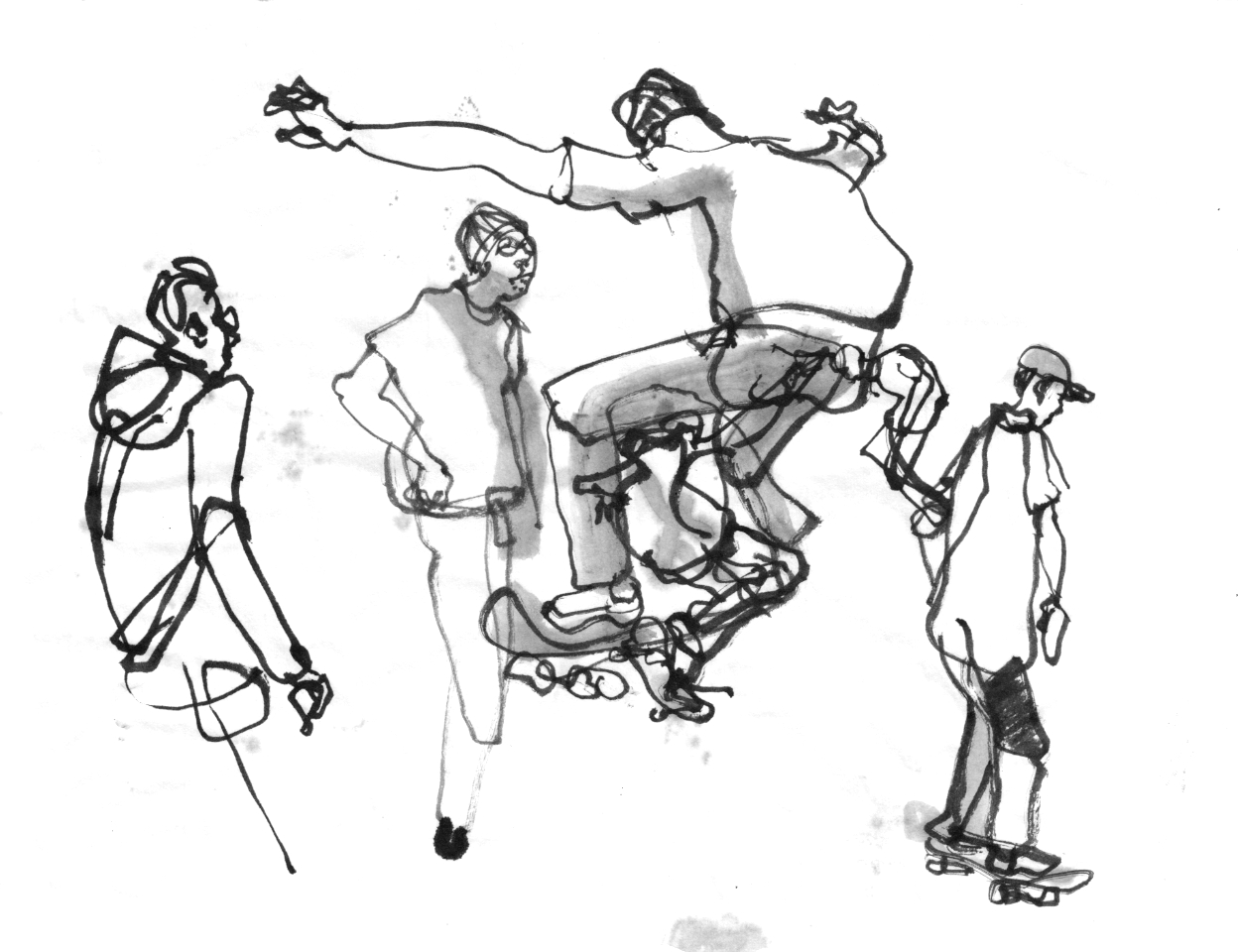

10 May 2021 | Today it is raining outside and the skaters are in the underground passage. First, they ride and jump on the blanc floor, then they use a trolley to fetch stuff stored nearby, a small ramp, things to jump over, a rail, etc
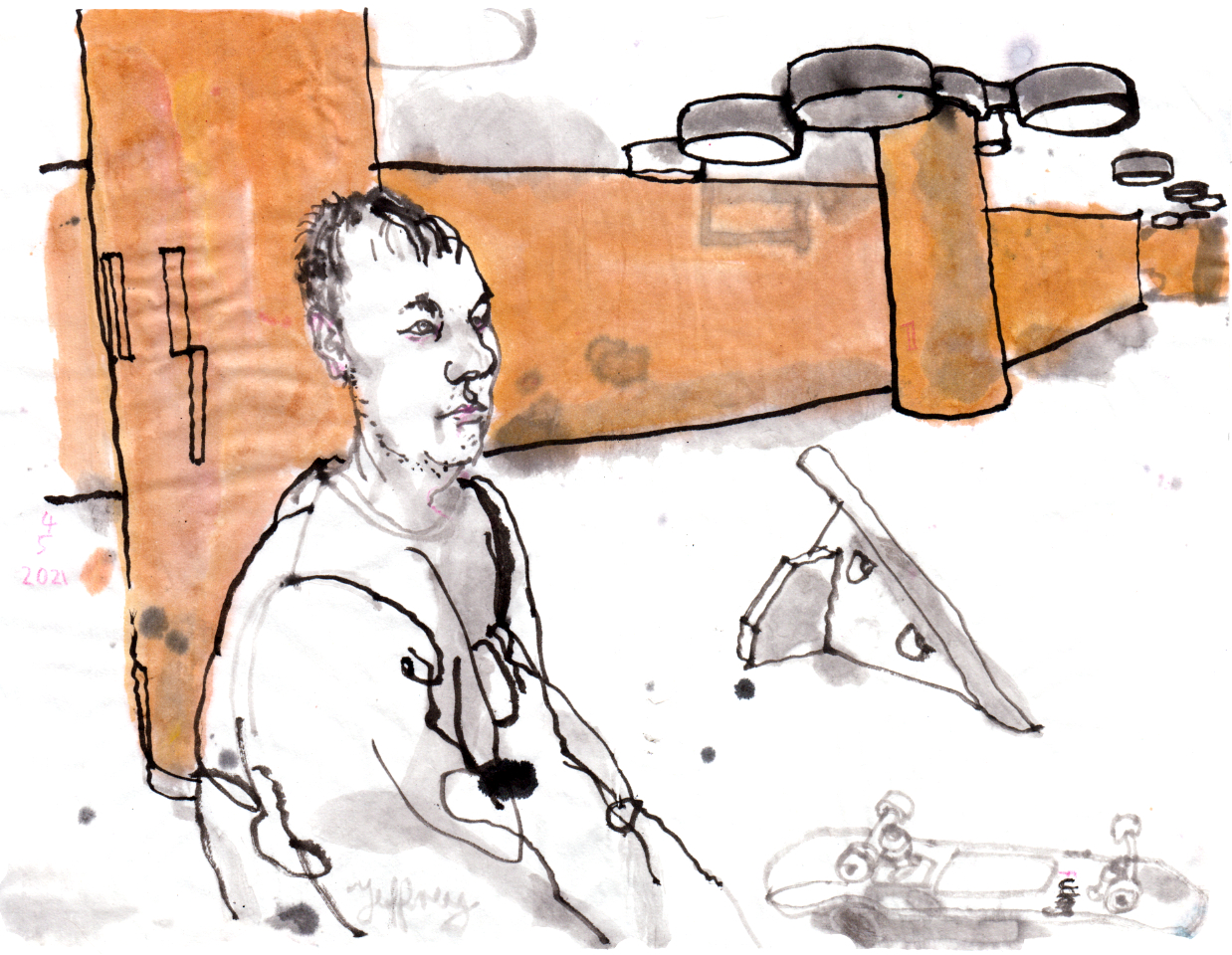
Jeffrey takes a break and we talk. He says he has been skateboarding for far too long since ’97, but he enjoys it too much. nothing else would do. They come down here when it rains. In good weather, they go outside, for example to a skate park near a youth centre in Spandau. In winter they are down here more often and also because of the smooth floor. Most of the time it works fine, but sometimes the police come. Generally, nobody comes, only when there’s a trade fair and now sometimes because of the vaccination centre upstairs. Skating has been going on here since ICC was built in 1969, he says. We also talk about calligraphy (he’s learning at the moment), paper, swan feathers and brushes, and anime.
Enjoy Kebab
Coming from the fair and the congress centre the ‘Neue Kantstraße’ crosses the wide aisle, that motorway and circular rail have cut through Wilhelmina city, via the ‘Ostpreußenbrücke’. Right at the corner of that bridge is a Kebab shop, named ‘Enjoy Kebab’.
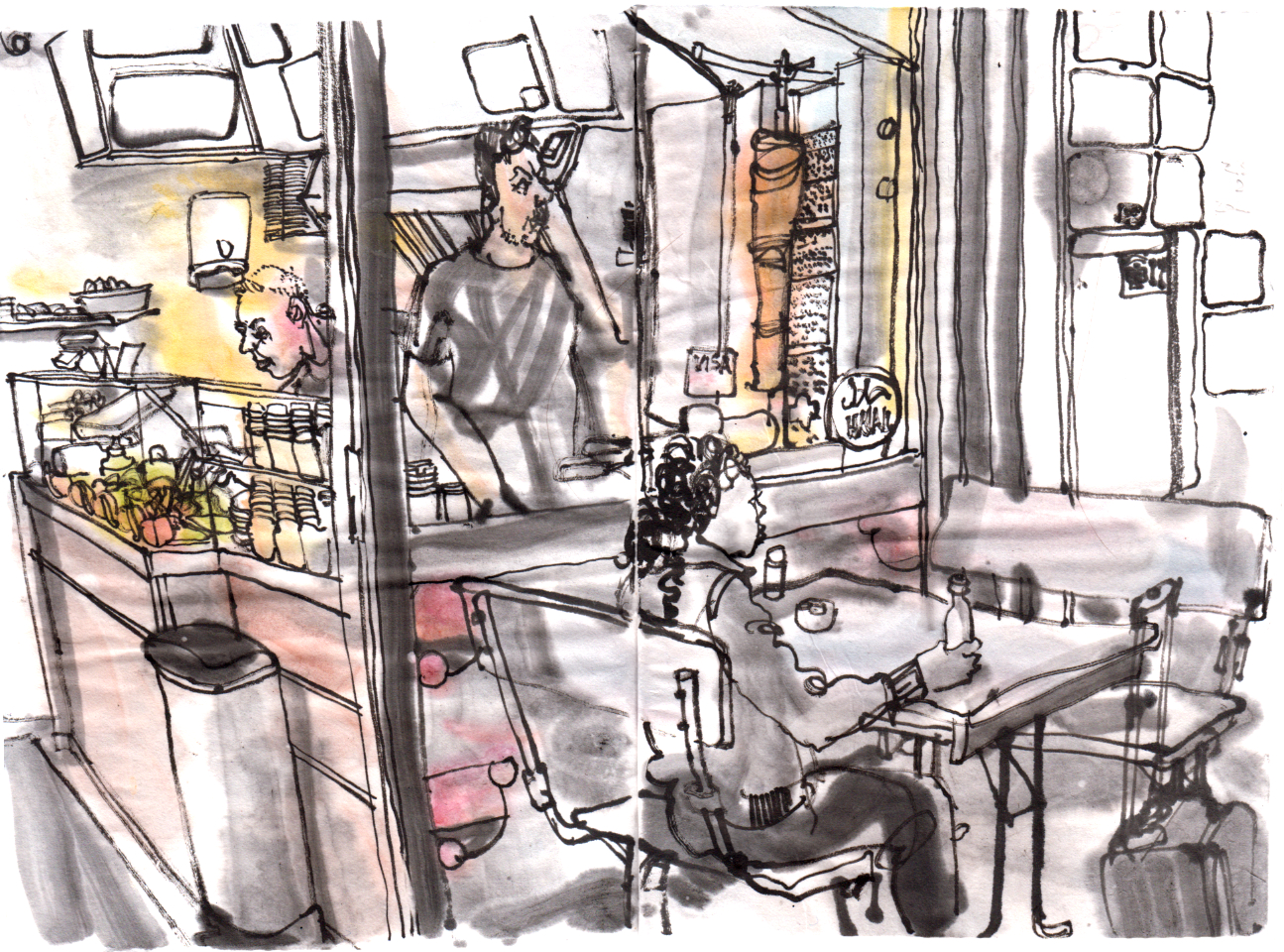
23 August 2021 | It is the first gastronomic thing, coming from that direction. A lot of guests have suitcases and order in English or with fingers pointing to the menu cards. Others are locals. The owner, standing by his vending window, chats with the locals and is patient and friendly to the travellers. A guy complaining about the food – order was misunderstood – receives a replacement to his liking without complaining. The place accepts all kinds of credit cards. Both are quite unusual for Berlin. The current host bought that place in 2013, he tells me. We both know the former owner, Mr Gunes.
About the lockdown, he says that business was ok for him. The shop is serving takeaway food anyway and it may have attracted clients that were locked out of their usual restaurants. He is more worried about the boom of food delivery, which he does not do and that would harm his business now. People would order from home now instead of coming for takeaway.
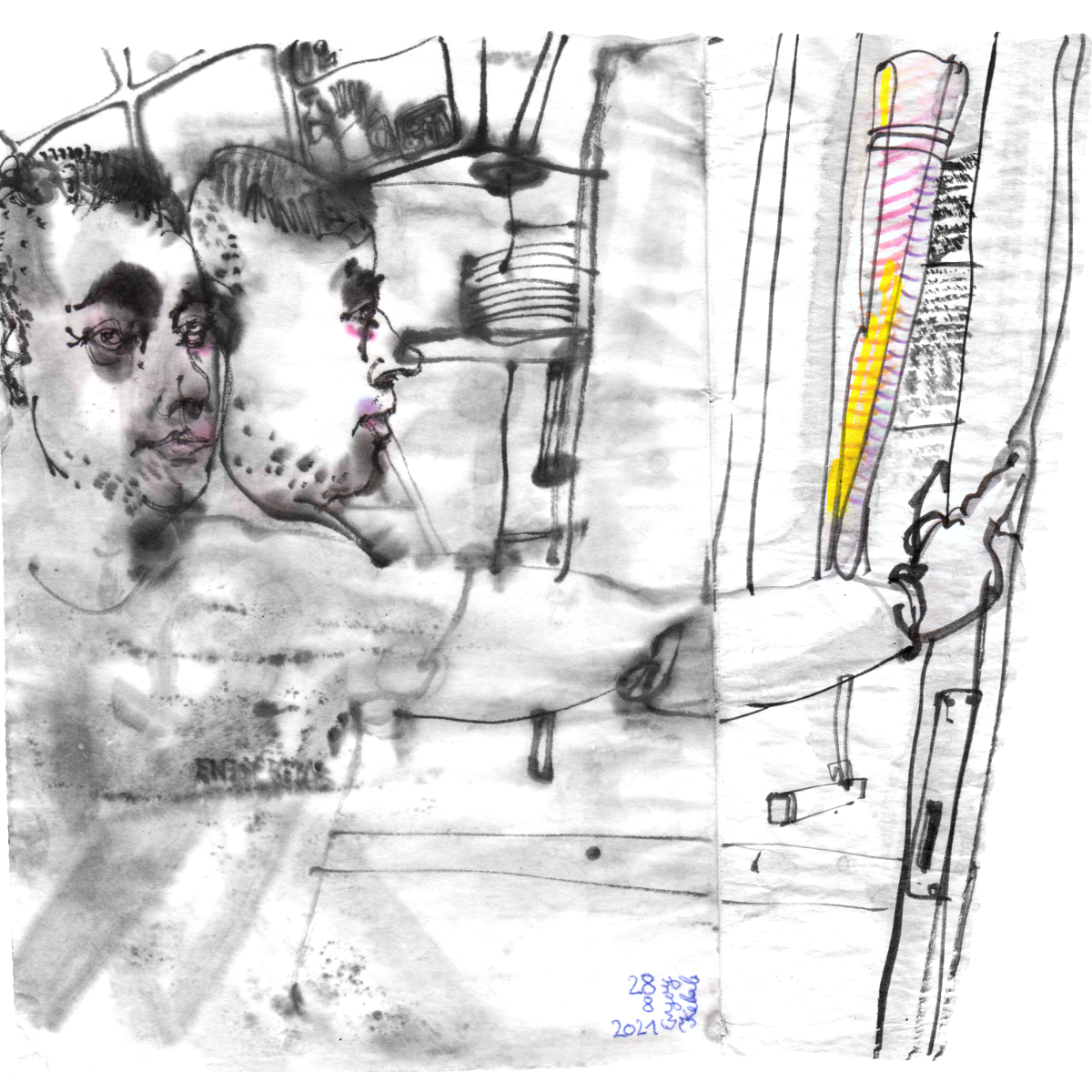
28 August 2021 | A few days later, it is August and after midnight, a group of three is sitting at the table by the vending window and chatting with the vendor. They ask him about his work, and all three agree that it is good to have work at all. The vendor is asked about working hours: “Eight hours work, then three for the family” – he starts at 6pm, normally till one am, on weekends often till three.
He is constantly moving, getting replacement drinks for the refrigerators from the cellar, cleaning this or that, only returning to the door for quick answers or cheering people passing by, trying to convince them to have a kebab. One of the three comes over and looks at my drawing.
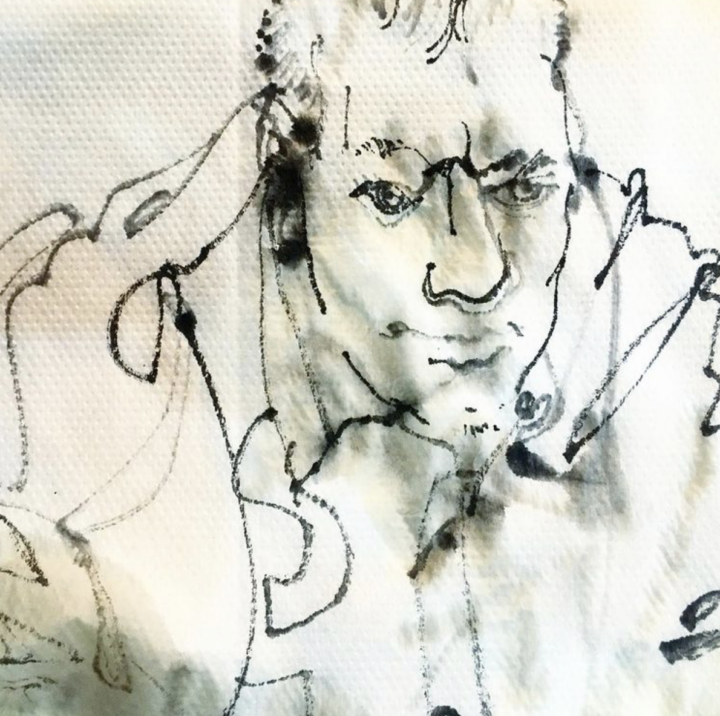
His wife suggests (without looking herself) that he might ask for a portrait. He does and I draw on a napkin, so he can have it. They are from Saxony, from a small village. He likes it there but needs to come to Berlin, for balance he says. So the three are here for the weekend.
It is a quarter to two when I leave and the place is still busy.
Riders
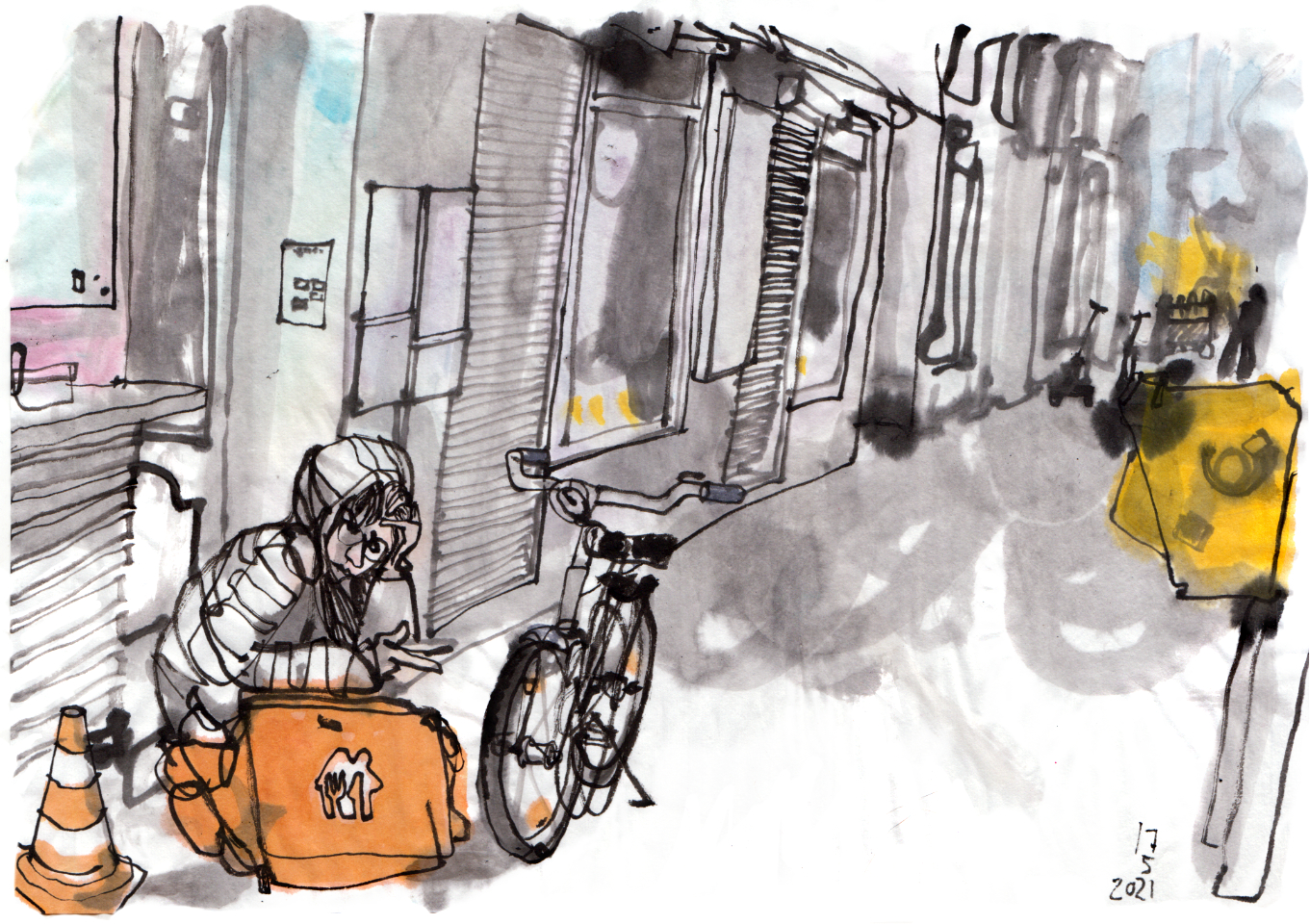
A woman is waiting in front of the Korean takeaway Son Kitchen to receive a bag of takeaway food to deliver to a client. She is one of the crowds of ‘riders’, delivery drivers on bicycles (and a few on e-scooters), that work for one or several delivery services. They are everywhere on the street, on tour on their bikes (own or company-provided), waiting inpatient in front of restaurants and nearly never taking breaks.
Food delivery has even been quite popular before the Covid19-pandemic. A lot of restaurants have their own delivery drivers, there are chain restaurants specialised in food delivery and companies that provide delivery service only, partnering with existing restaurants.
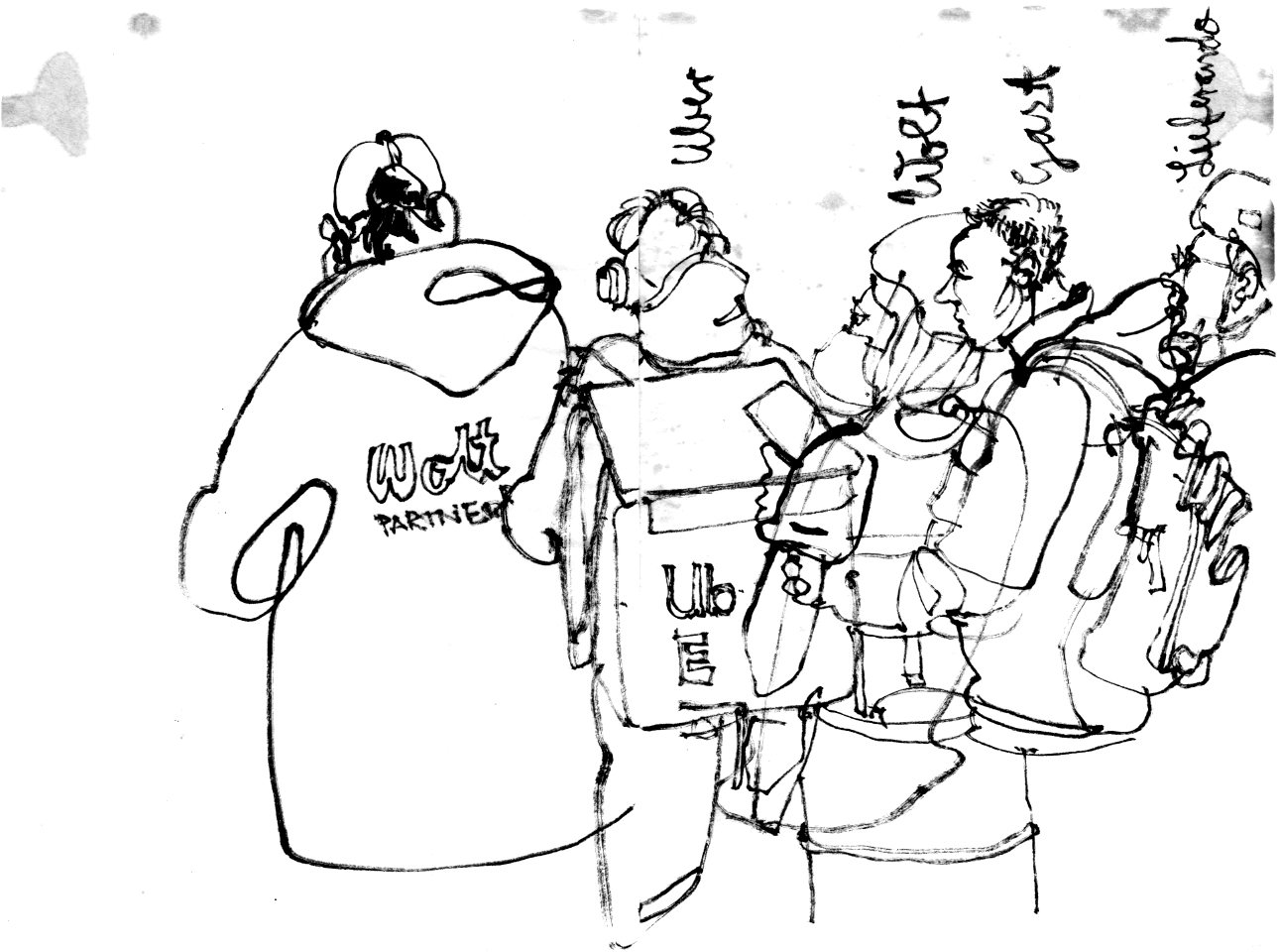
The latter had a boost in the pandemic. With lockdowns, restaurants were in need to get take away food to their clients to maintain business and survive. Instead of organizing their own service, they partnered with the companies providing ordering websites, packaging material and most importantly a huge crowd of ‘riders’. The working conditions of these ‘gig-economy-workers’, their status as bogus self-employed or employees with cut workers’ rights, is the subject of public debates.
Recently, this organisational scheme has also been increasingly used for grocery deliveries.
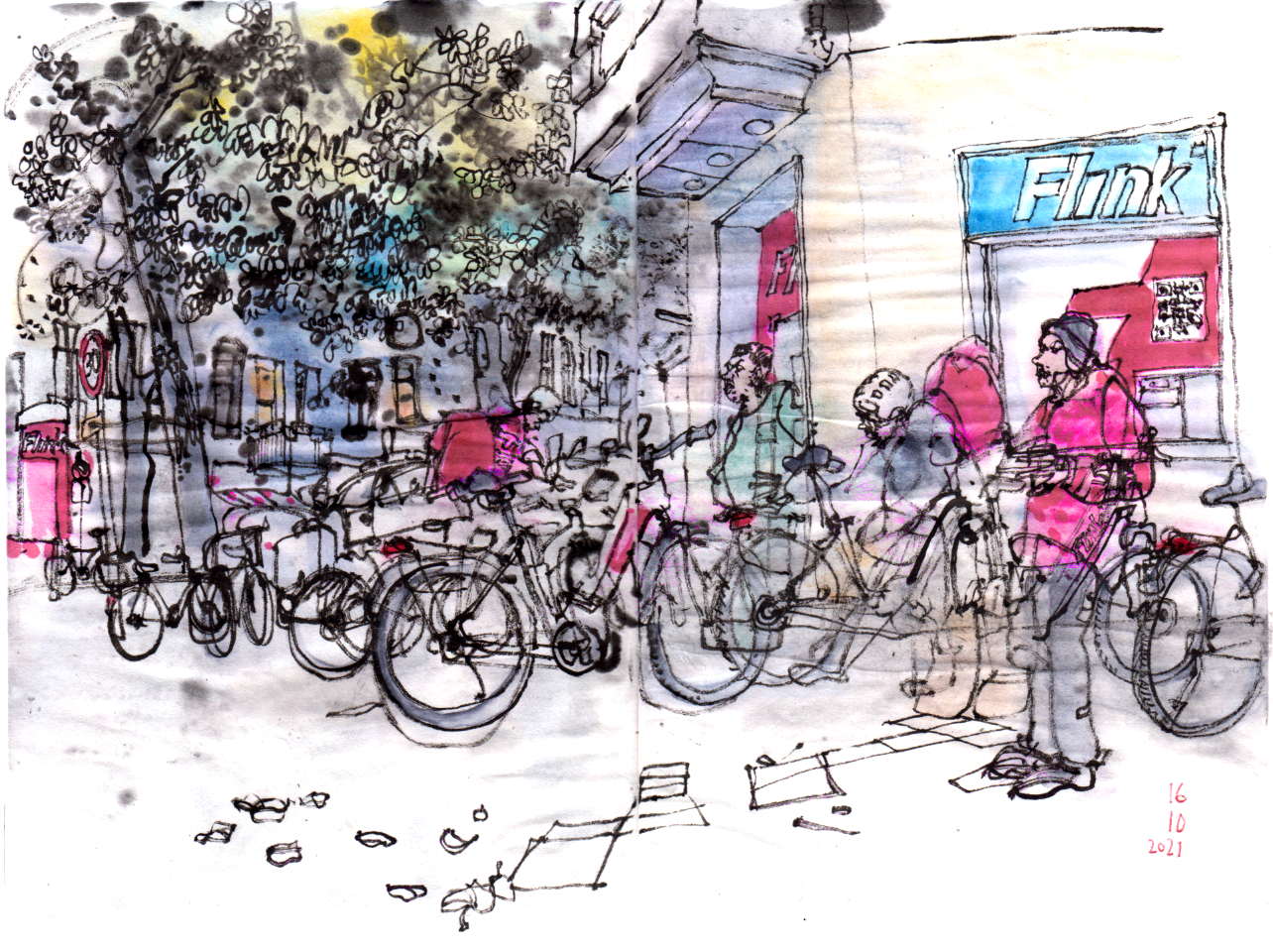
16 October 2021 | On the ground floor of the Kantstraße / Windscheidtstraße corner building is now a warehouse of one of those grocery delivery services – ‘Flink’. There are lots of e-bikes in front of the door, and storage shelves can be seen through the doorway in the flink pink cladding. Delivery drivers, mostly men and a few women, arrive constantly and usually leave again after a short stay with newly packed backpacks. Only one man takes time for a coffee and a cigarette.
I never managed to really talk to one of the riders, they are obviously too busy for that and apologize, no time, if asked.
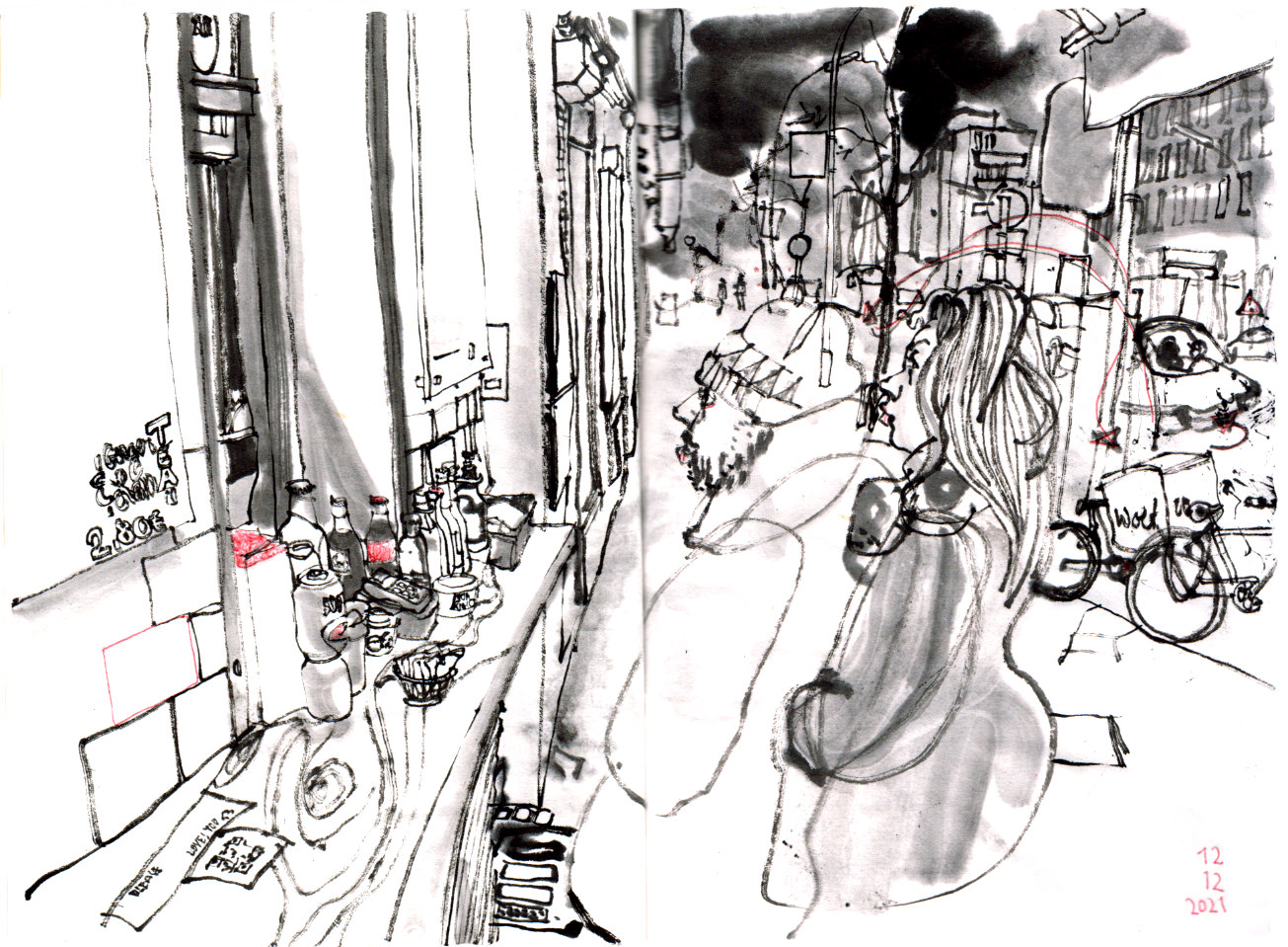
12 December 2021 | A rider with a ‘wolt’-box on his bike appears at Son Kitchen, cues in front of the window and when it is his turn quickly grabs his bag of food to deliver, packs it in the box and rides his bicycle down the wet street.
Late Night Shop Kant 123
All along ‘Kantstraße’ are late-night shops. They sell Tobacco, foods like crisps etc., some newspapers, some essential housewares, but most of all drinks. Depending on current regulations of pandemic control, one had to take away the drinks (to the next corner or park …) or could drink it right in front of the stores, which sometimes have provisional furniture to place bottles or even sit.
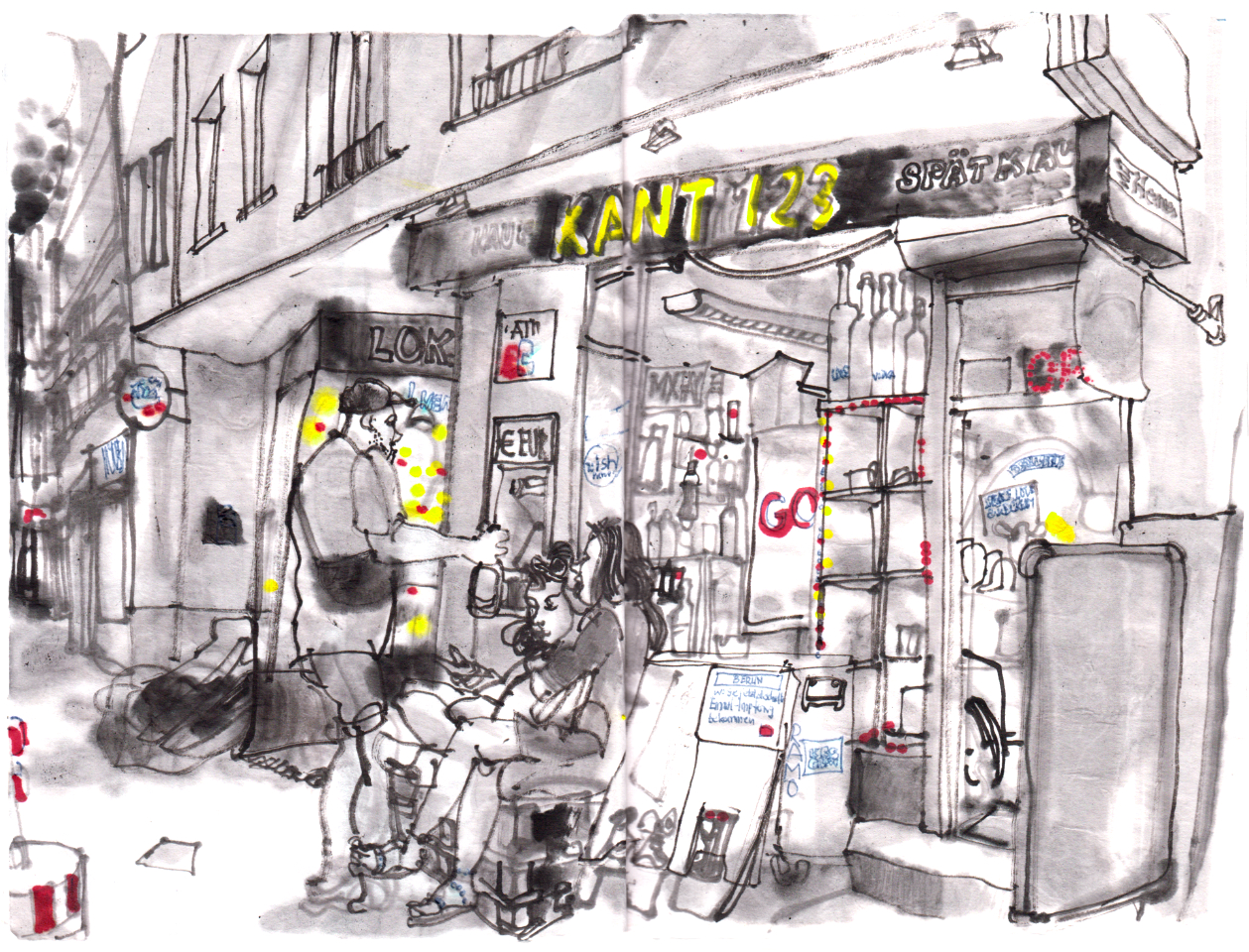
15 July 2021 | In front of the late-night shop Kant 123 there is now a couch made of Euro pallets covered with grey cushions. The cushions were packed away during the lockdown when consumption in front of the shops was banned and persecuted. Now they are back and a tall man is talking loudly and cheerfully with two women, sitting on that couch. I can’t make out the language. He keeps going into the shop to get more beer. One woman sees me drawing and comes over to have a look. I’ve already drawn the man and she recognises him, she says that’s her boyfriend. The three of them continue to party. Now and then they come over to look at the drawing. I ask the woman from the beginning – she also speaks German – what language they speak together: Mongolian, no one would ever recognise that. One probably doesn’t hear it that often. She has lived in Berlin for a long time.
The chef of Han BQ
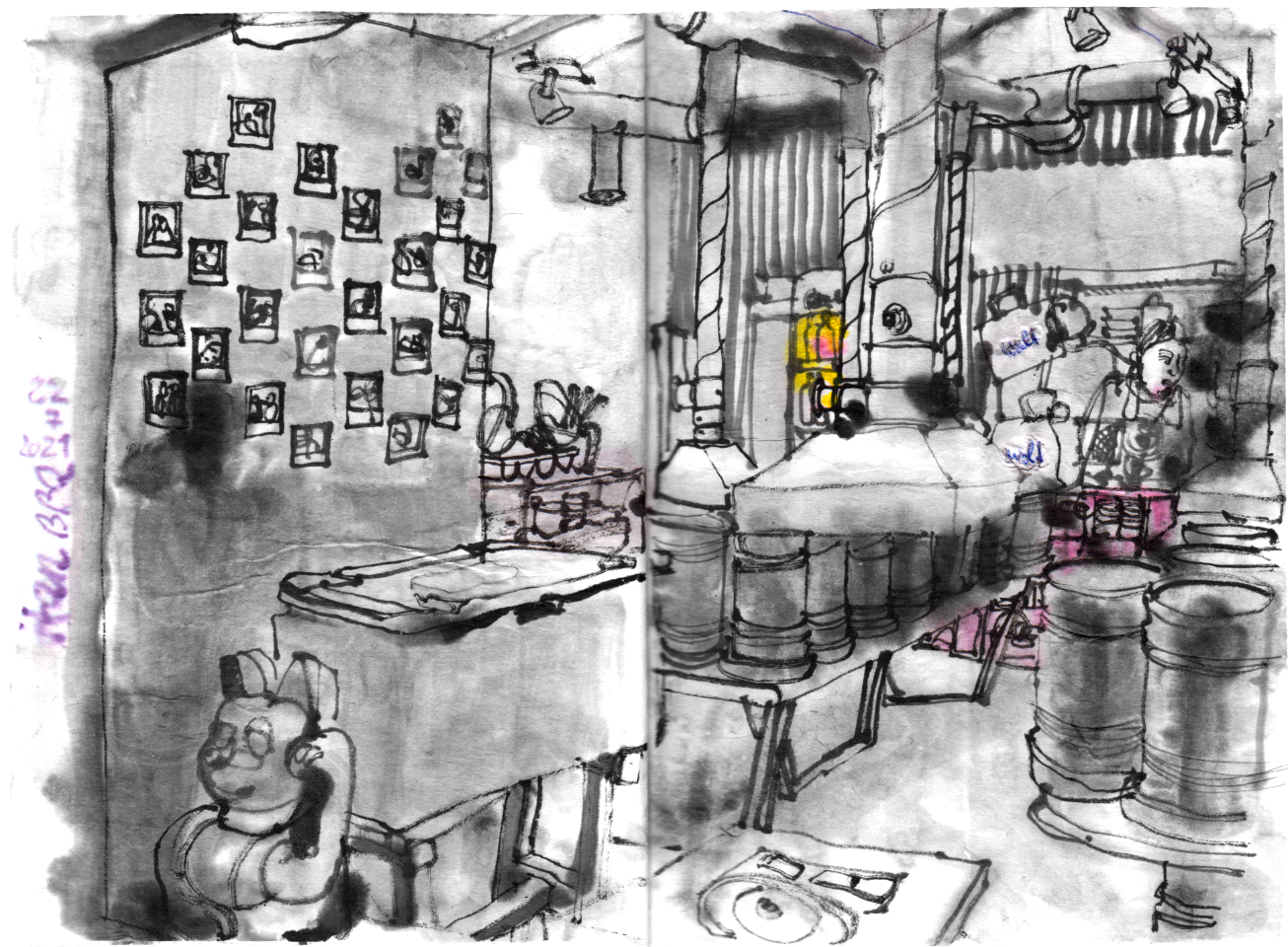
22 July 2021 | Through the window I watch the Korean barbecue restaurant Han BBQ being tidied up. There is still a little light, the restaurant has cooking stations at the tables, over each of which hang metal hoods. Stools made of tin barrels stand upside down on the tables, and a young woman and a young man work intently. He comes out with one of the stools, I’m welcome to sit on it, he says. Later we talked. He tells me about his father, who was a Math teacher and later became a professor for animation in Korea. He is interested in drawing too but talks even more passionately about gastronomy. He has been in Berlin for 11 years now, working as a cook for six years, solely in Star gastronomy, before he became the chef of this Barbeque.
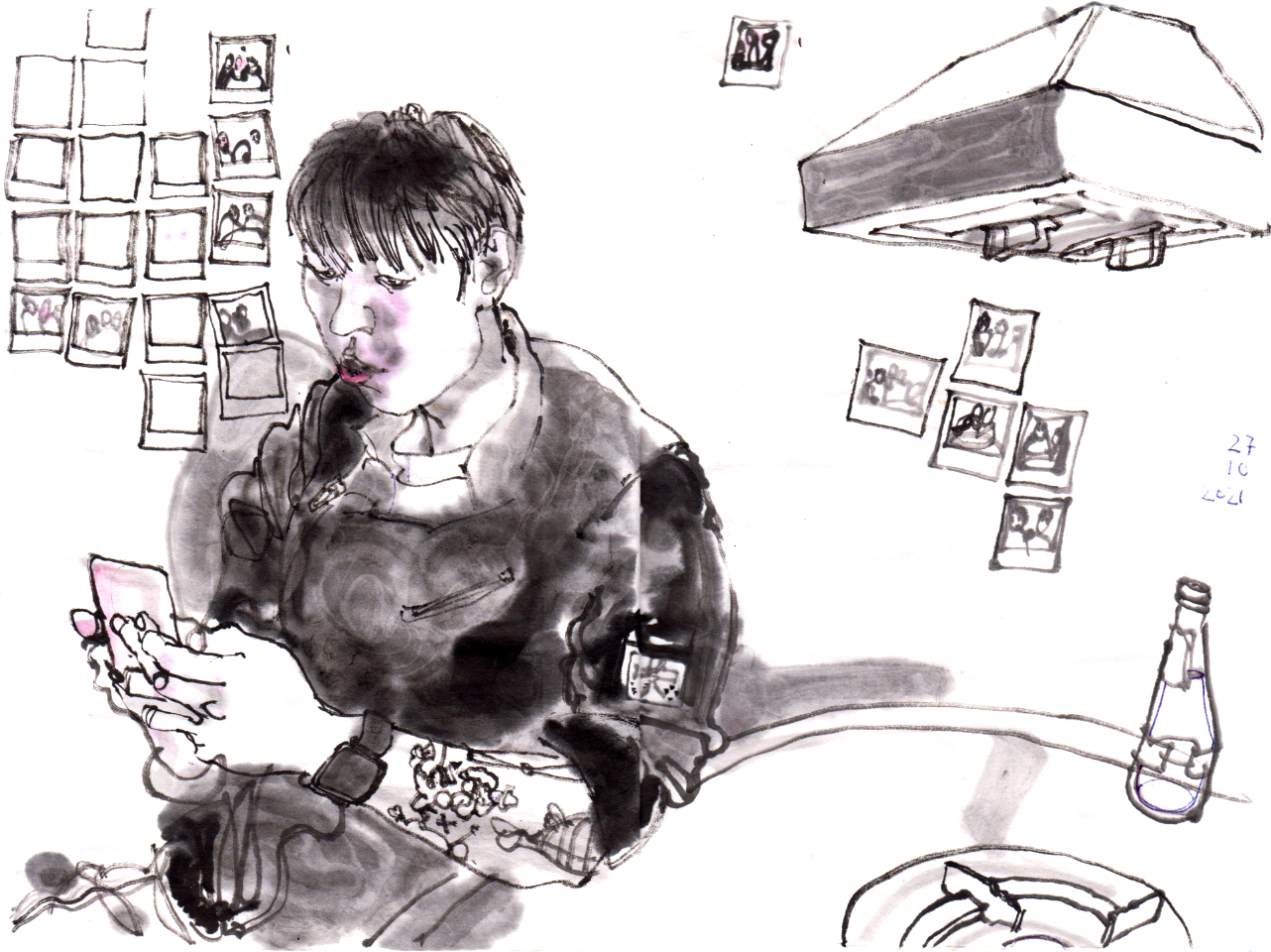
27 October 2021 | When I see Chanvly in the evenings, he is always busy, so we agree on a meeting in the afternoon for a portrait. We got 30 Minutes to sit at one of the tables in the restaurant. Polaroid photos of happy guests are stuck on the walls. I always see the guest room as depicted in the photos, when I pass by in the evenings, filled to capacity. Now at four o’clock we enjoy the silence, the colleague arrives, soon they open and we agree to talk another time.
Lokma Company
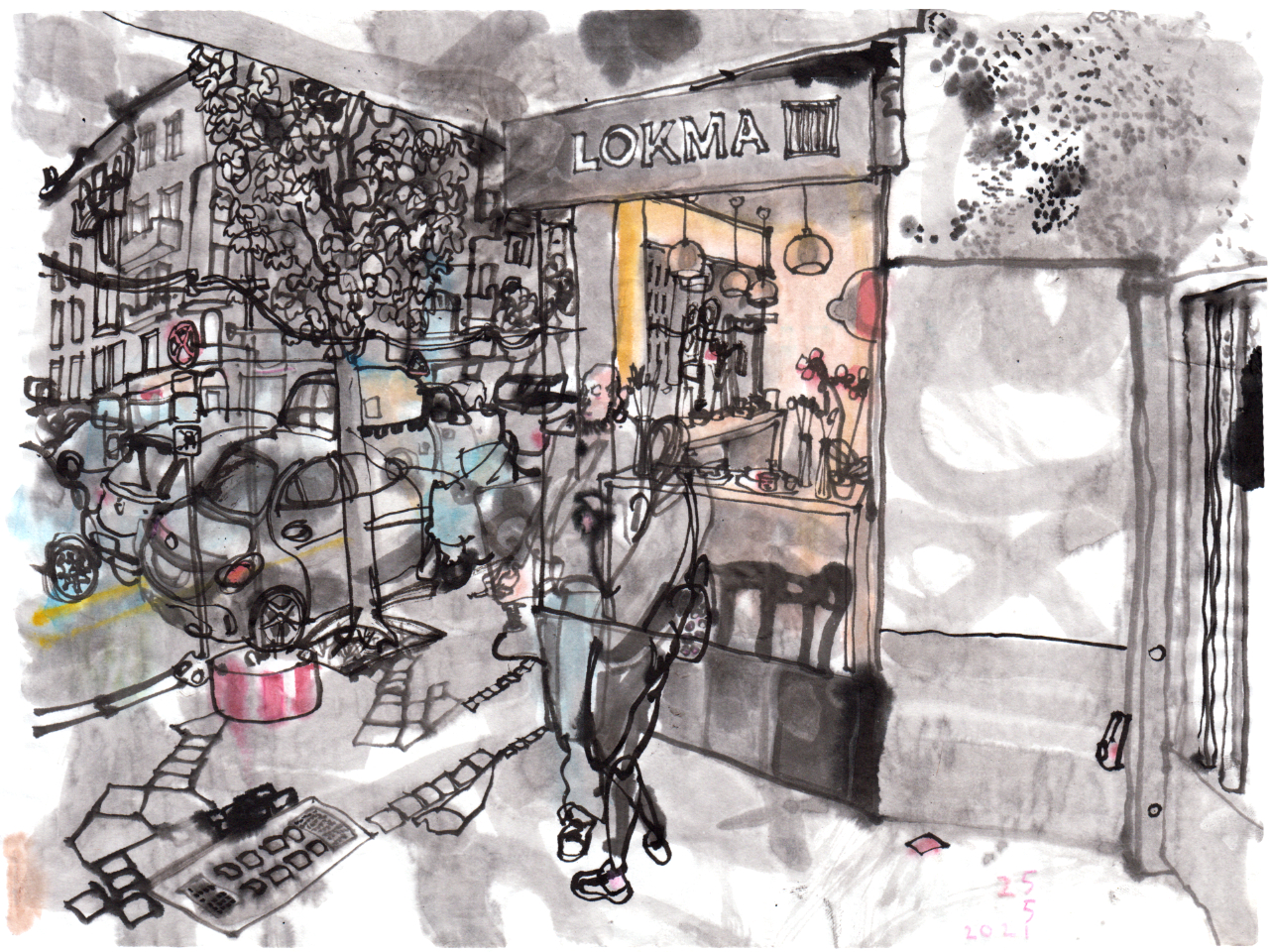
I first met Nissene (I hope I’m spelling it right) in May this year. I had drawn the shop where he is actually always to be found, the ‘Lokma Company’, and he brought out some Lokma for me to try. Since then I see him often, he is always remarkably nice and cheerful.
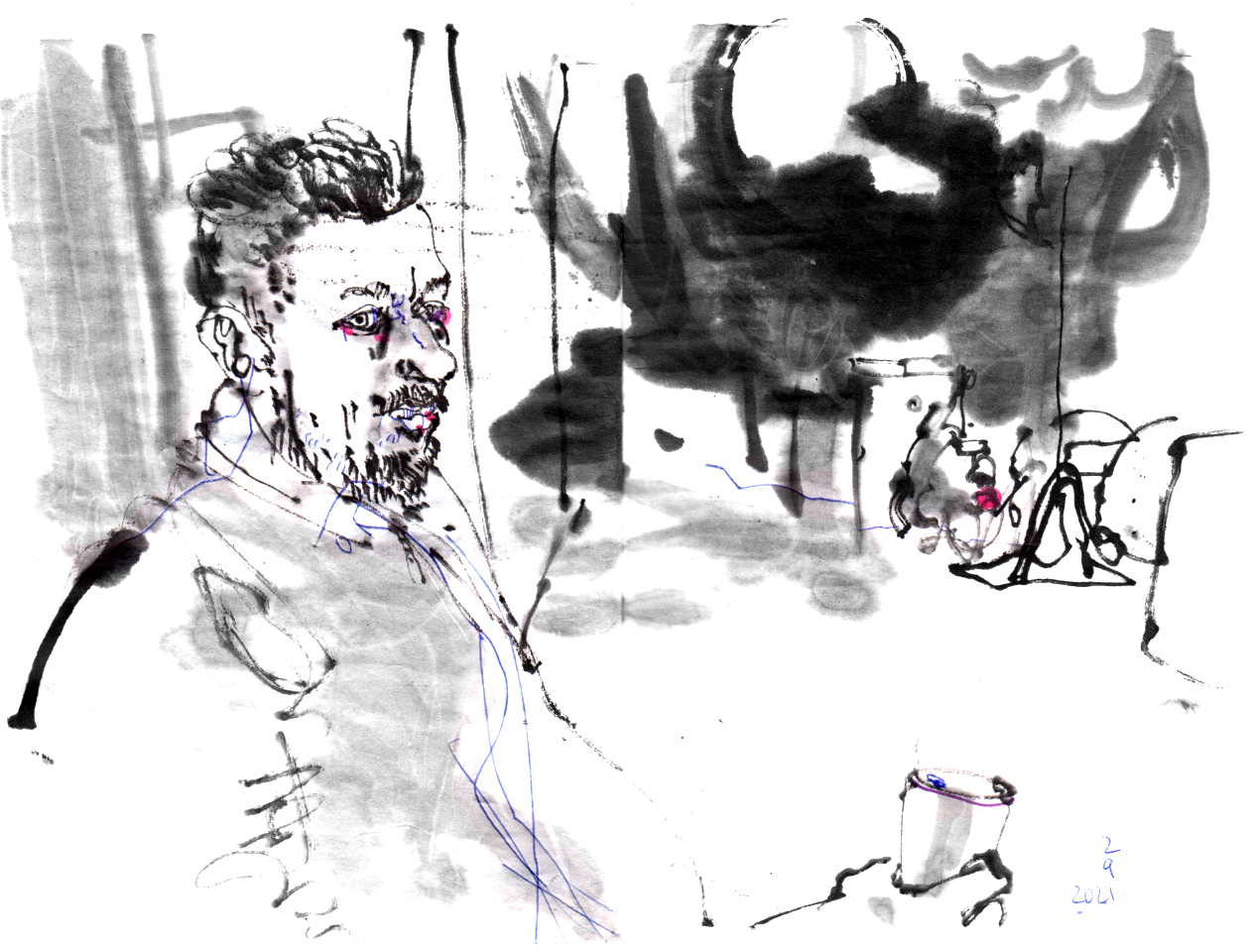
3 September 2021 | Today I meet him on the sofa made of pallets at Späti Kant 123, next to the Lokma shop. It’s already closed and an employee is cleaning up inside. It’s after midnight and the late-night shopkeeper also closes his shop and goes home with his big dog.
I ask Nissene about the success of the shop. They opened it in January, in the middle of the lockdown. He says it’s quite good in the evenings – in fact I always see customers there – but during the day business is a bit quieter than they had hoped. But let’s see, it’s actually doing okay. He and the company that runs it has only built exhibition stands before. Maybe that’s why the design of the shop looks so perfect that I first thought it belonged to a chain. But it’s only this one (so far).
By Ali
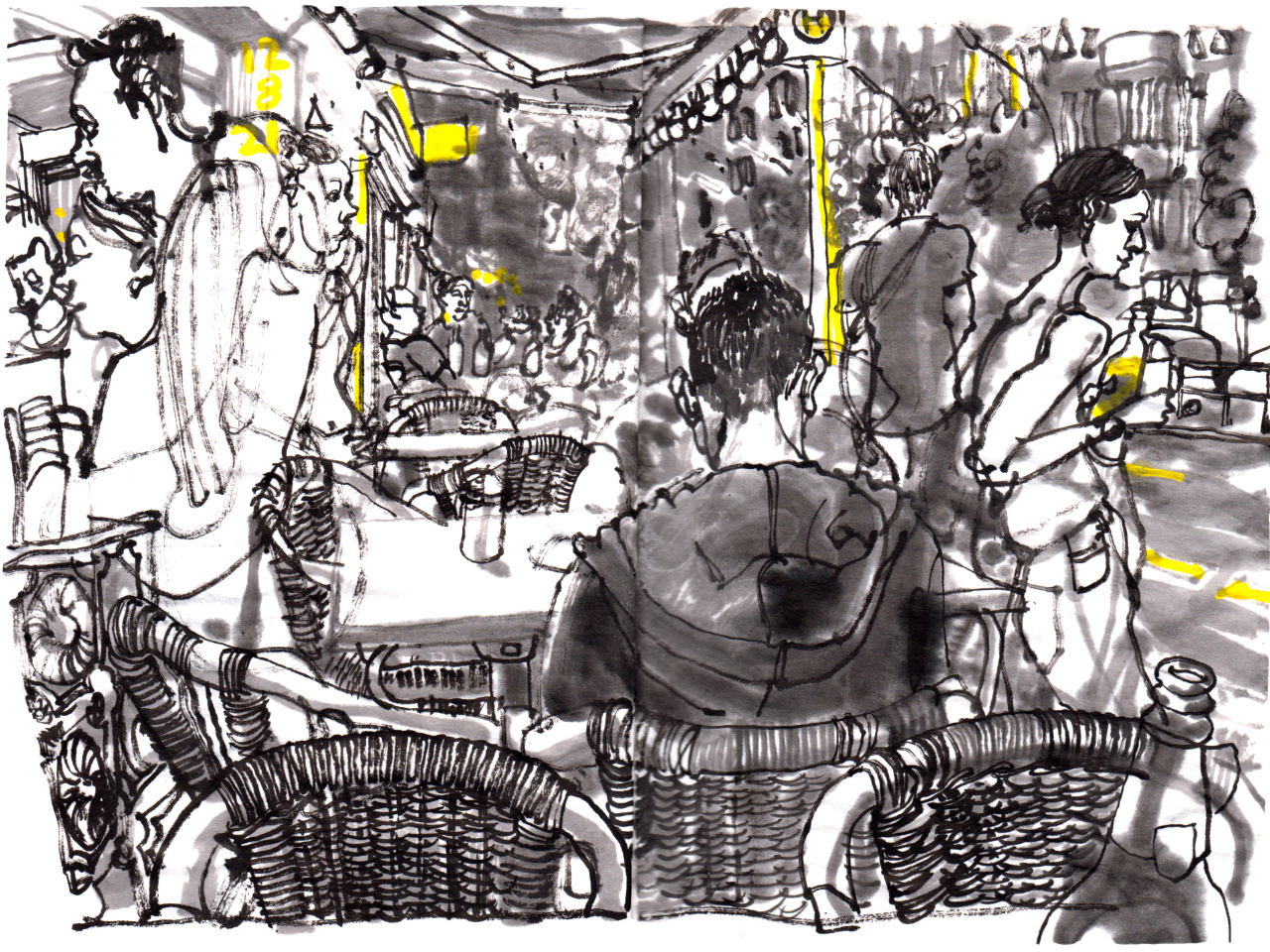
12 August 2021 | At the intersection of Leibnizstraße I get a kebab and sit down at a table on the side-walk. There is a bus stop in front of the kebab shop. Guests order “as always”, take their food home or a beer to a table.
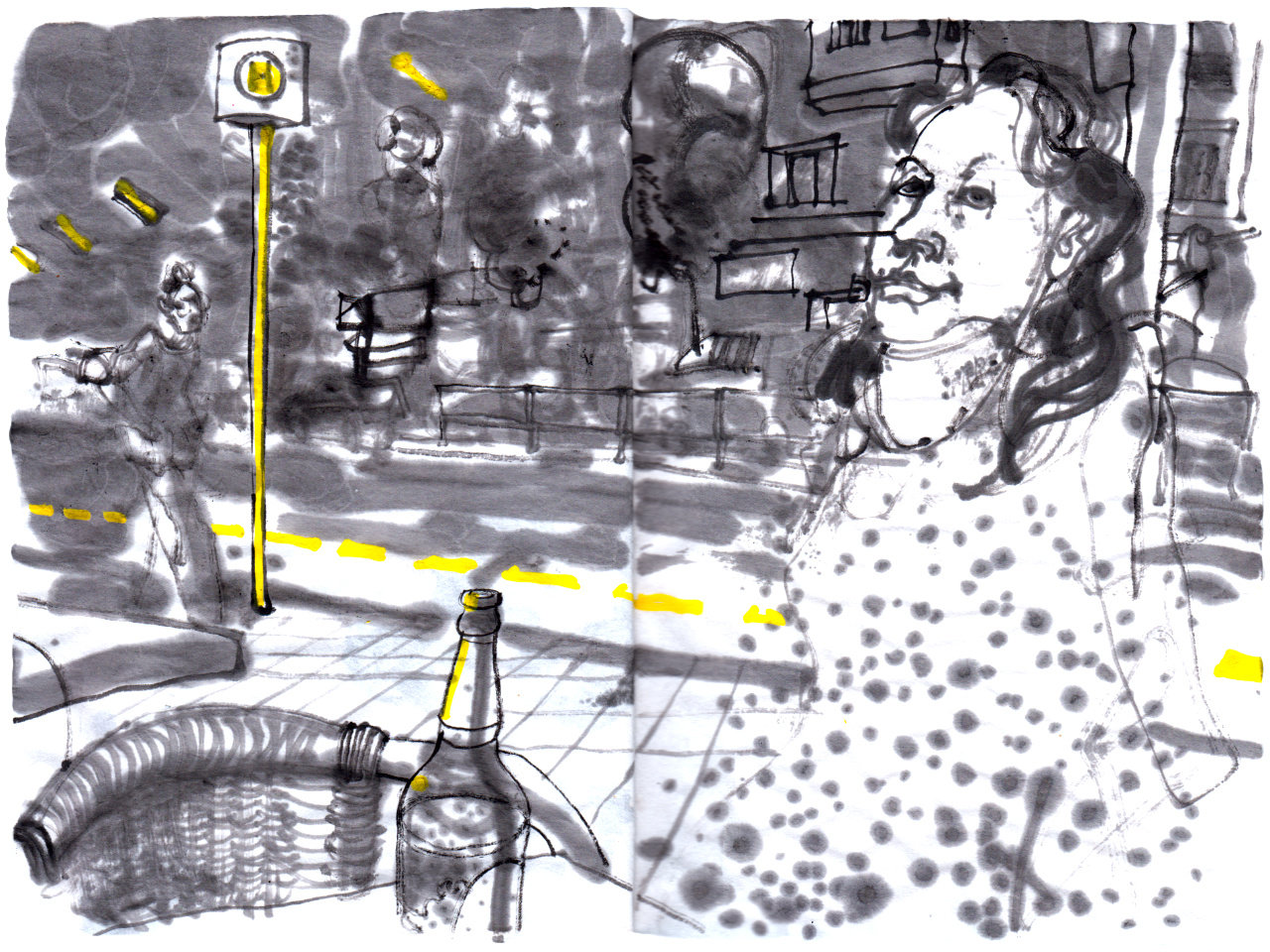
At the back of the shop there are two slot machines, at one of them a woman sits alone, her FFP2 mask half put on. A little later she comes out, puts her beer on my table and rummages in her bag for a long time. She has food for home in a bag. Finally she finds a BVG ticket. I ask her if she has a moment and if I can draw her. First she wants to have the drawing when it’s ready, but then she doesn’t – “me? no” , pointing to the drawing. Her bus comes and she quickly gets on and is gone. She leaves her half full beer on the table.
New West Club

31 July 2021 | The latest lockdown is nearly over, even clubs are allowed to open again, with limitations, though.
Saturday evening I see barriers, and a table with disinfectant, masks and an admission QR code in front of the New West Club. The operators are at the door and soon a queue of young people cue on the pavement.

Already here the mood is cheerful, some groups just chat for a while with friends and leave without trying to get in. Others wait patiently with negative proof and Luca app drawn. The door management seems to be quite rigid, no one is let in for long periods of time, only when people leave new ones are allowed in.
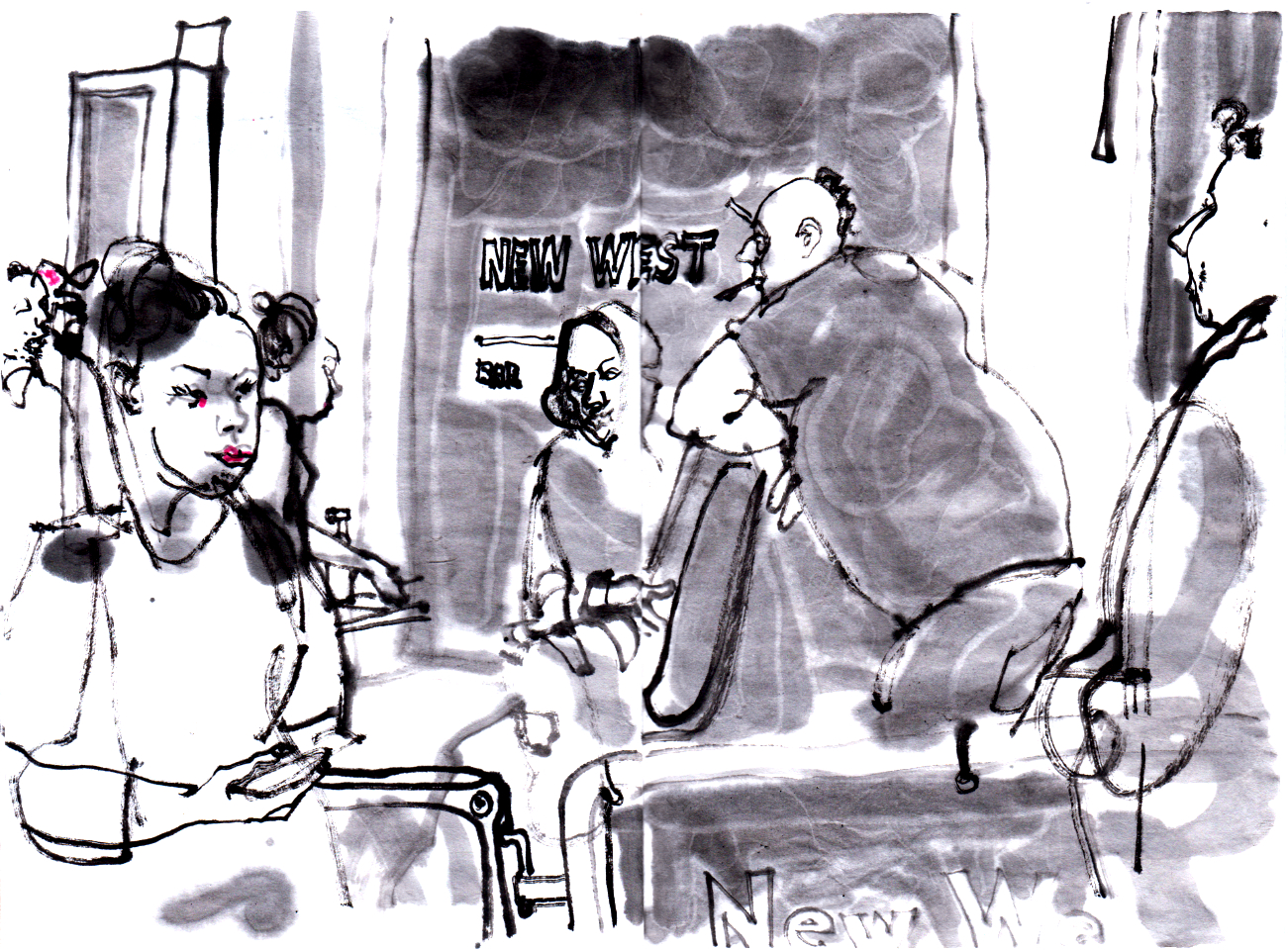
Everybody is friendly, but I don’t know to what extent the presence of a very tall and broad man next to the door contributes to this.
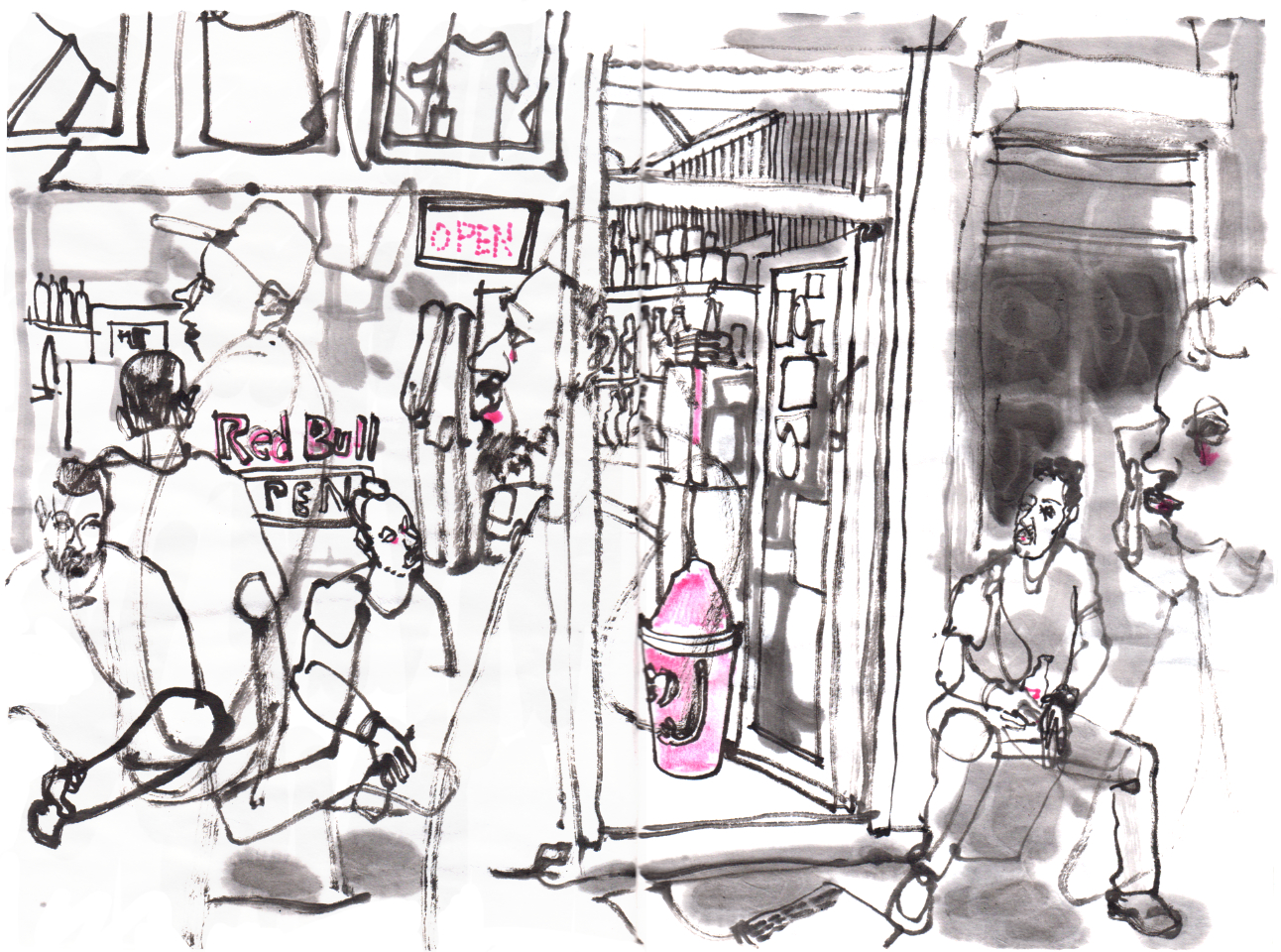
Guests come out of the club, take a breath, chat or get something to drink at the neighbouring Späti. There’s a table with two chairs in front of it, regulars and club guests sit alternately. Another regular sits calmly on a beer crate next to the door, gets up every now and then to get another cold beer and doesn’t pay any further attention.
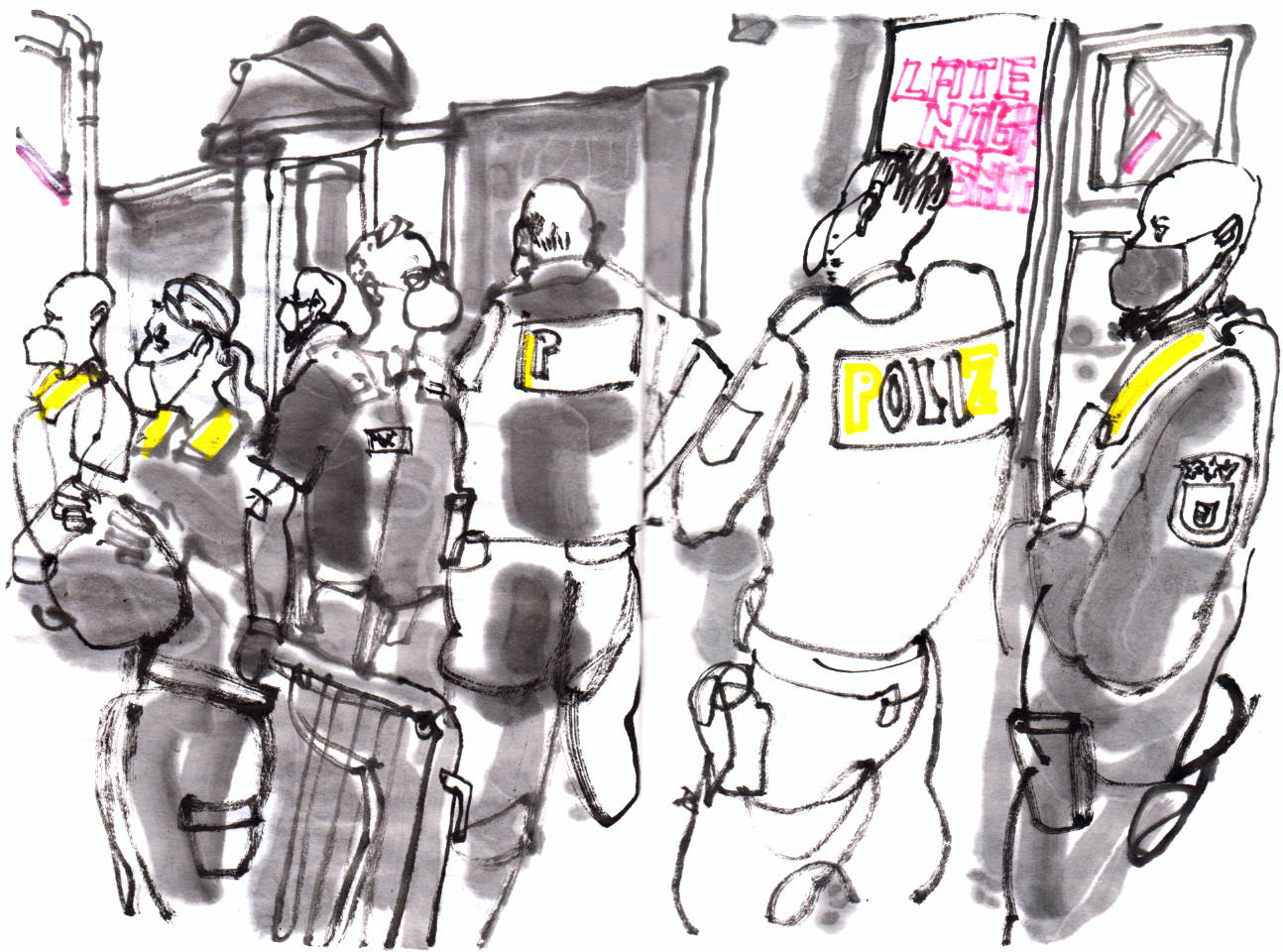
He also remains unconcerned when a group of policemen arrive and want to enter the club to check compliance with hygiene regulations. The tall, broad man doesn’t want to let them in. He sees the constant visits as business-damaging harassment and insists on domiciliary rights and a court order. While he negotiates with police officers, more and more armoured police officers appear, but they stand very calmly, observed by interested club guests. One guy asks an officer if it’s allowed to draw police officers like I do. He says it’s no problem, they can be photographed, it’s okay. The doorman finally lets the Police in, all ok, it seems. One of the operators calls the guests to either come in (with masks!) or leave, the crowd on the pavement seems to worry most. He (berlin-) politely asks the Späti host to “clear his terrace” at 2am, and he actually carries his two folding chairs inside.
The singer
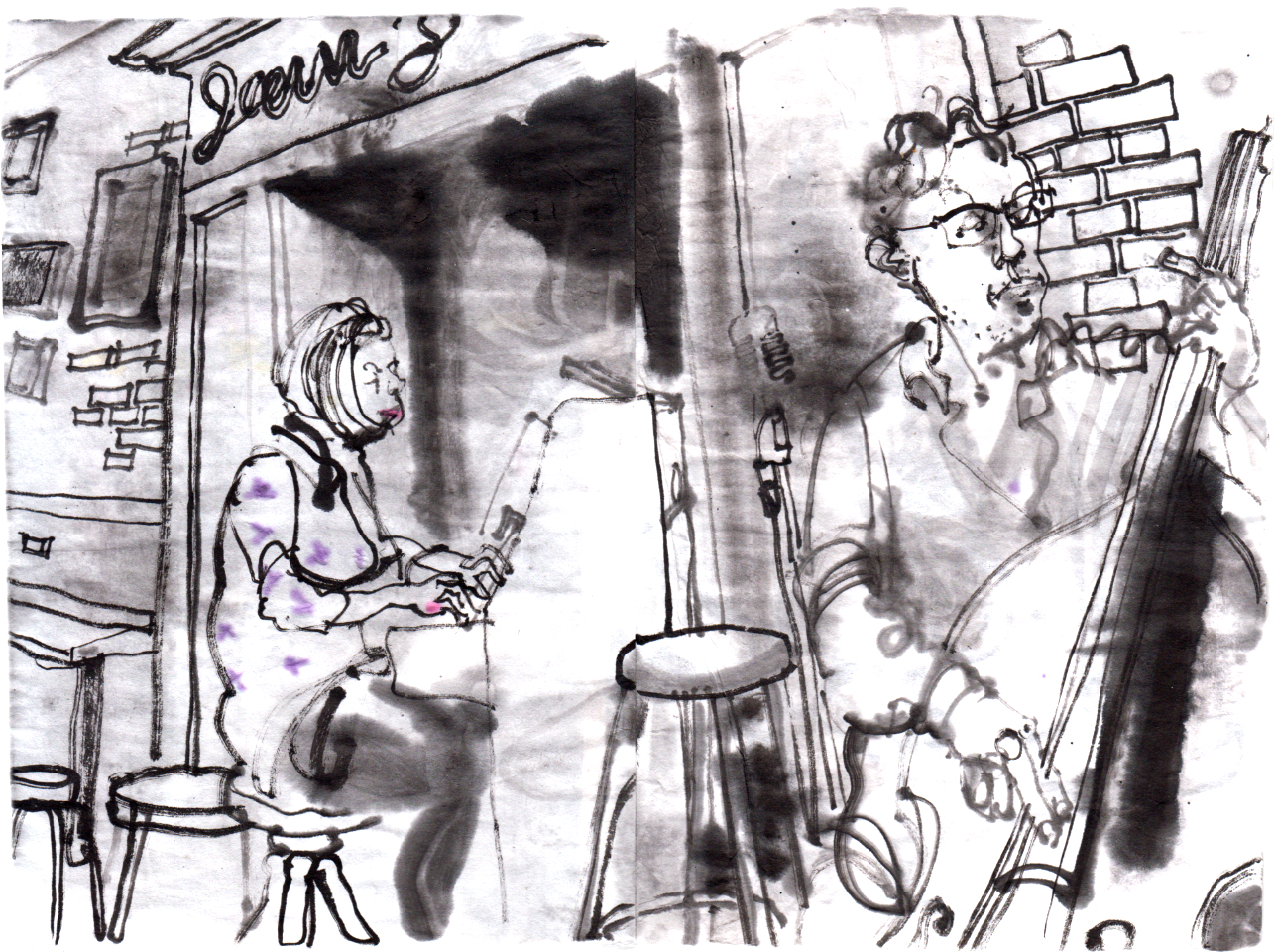
9 September 2021 | Live music is back at ‘The Hat Bar’ at Kantdreieck close to the western End of the Kantstraße and the Station Zoo. Like before the Pandemic there is an open jam session every night from 9 pm. Fortunately, the bar has survived the lockdown. In a barrel vault under the S-Bahn is the narrow stage opposite the bar, where there are cocktails and whisky and beer, and on stage Carolyn De Rosario plays piano, Carmelo Leotta bass and a drummer whose name I don’t know.
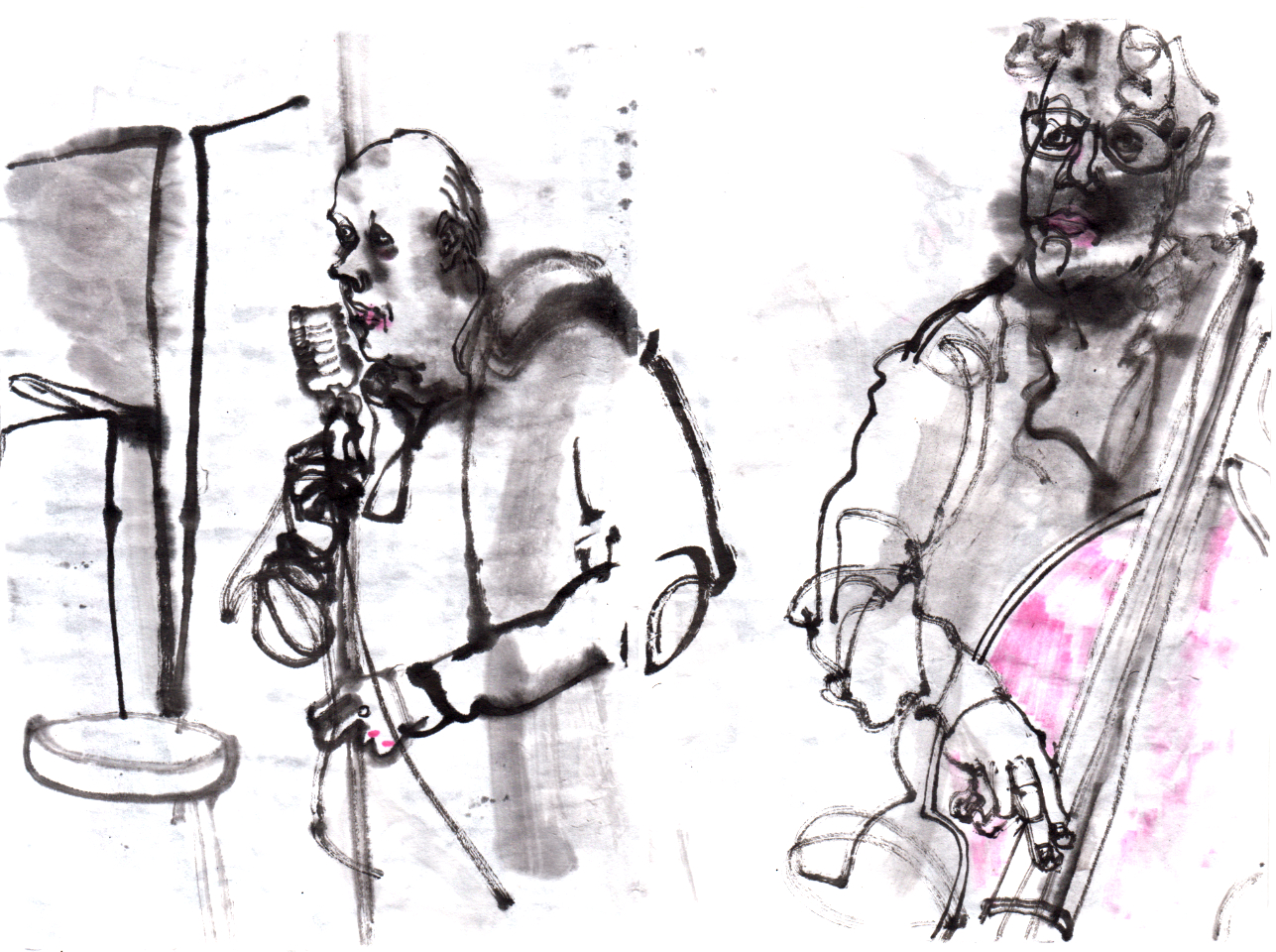
A nervous-looking man talks to the pianist and bassist – he wants to sing and seems to be known here. On stage he suddenly seems very present and calm and sings confidently and professionally.
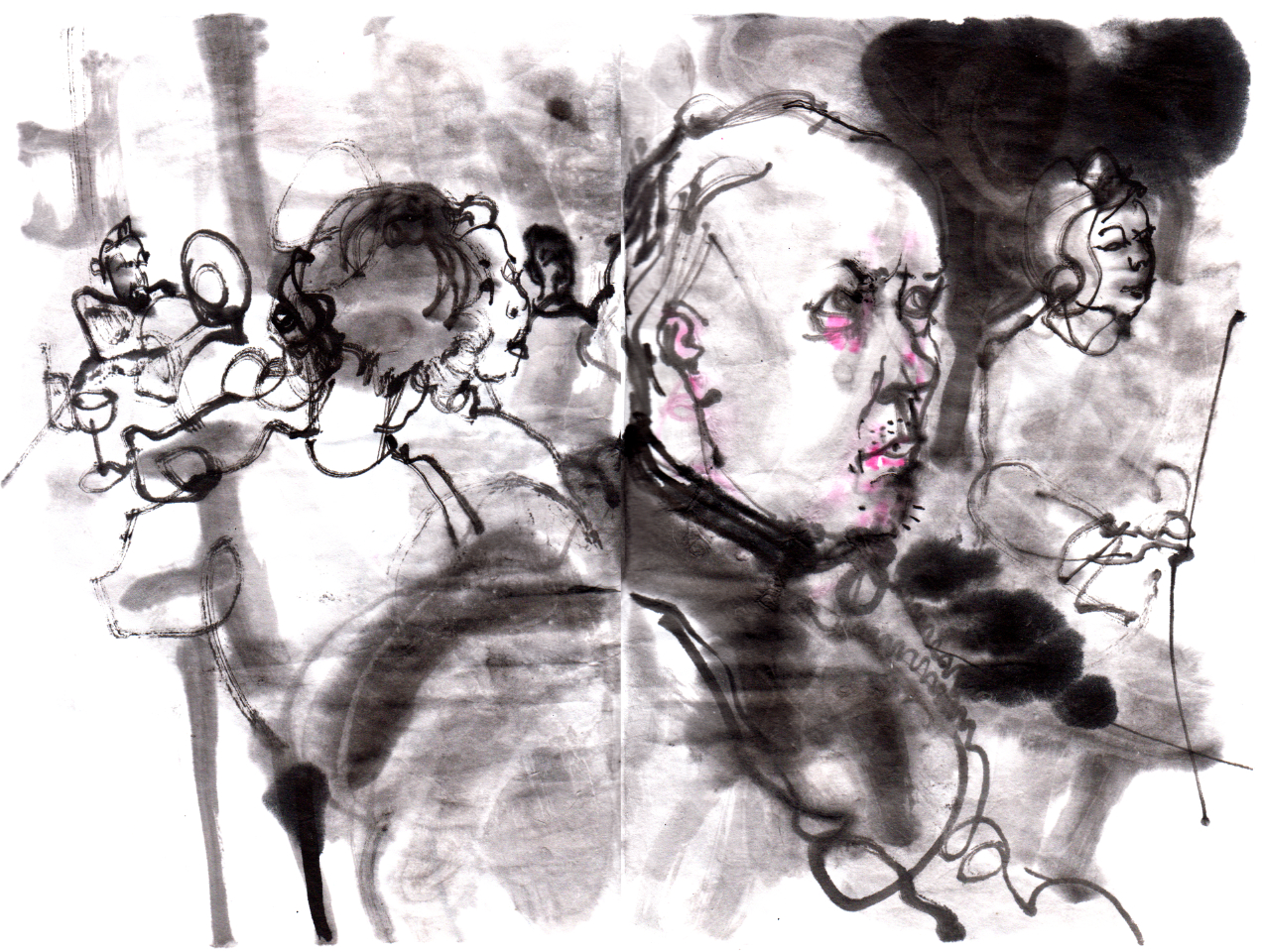
After his performance, he is questioned by a very talkative man sitting at the bar with his family. Otherwise, he only sings on the street. That’s where he has his spots. Unfortunately, the family man talks a lot and the singer hardly gets a word. Finally, the family leaves and I ask the singer if I can draw him. He agrees. He doesn’t feel like talking. He apologises, he has to clarify whether the musicians know his songs – it seems so – and he goes back and forth a lot.

One after the other, two women sing, reading the lyrics from their mobile phones.
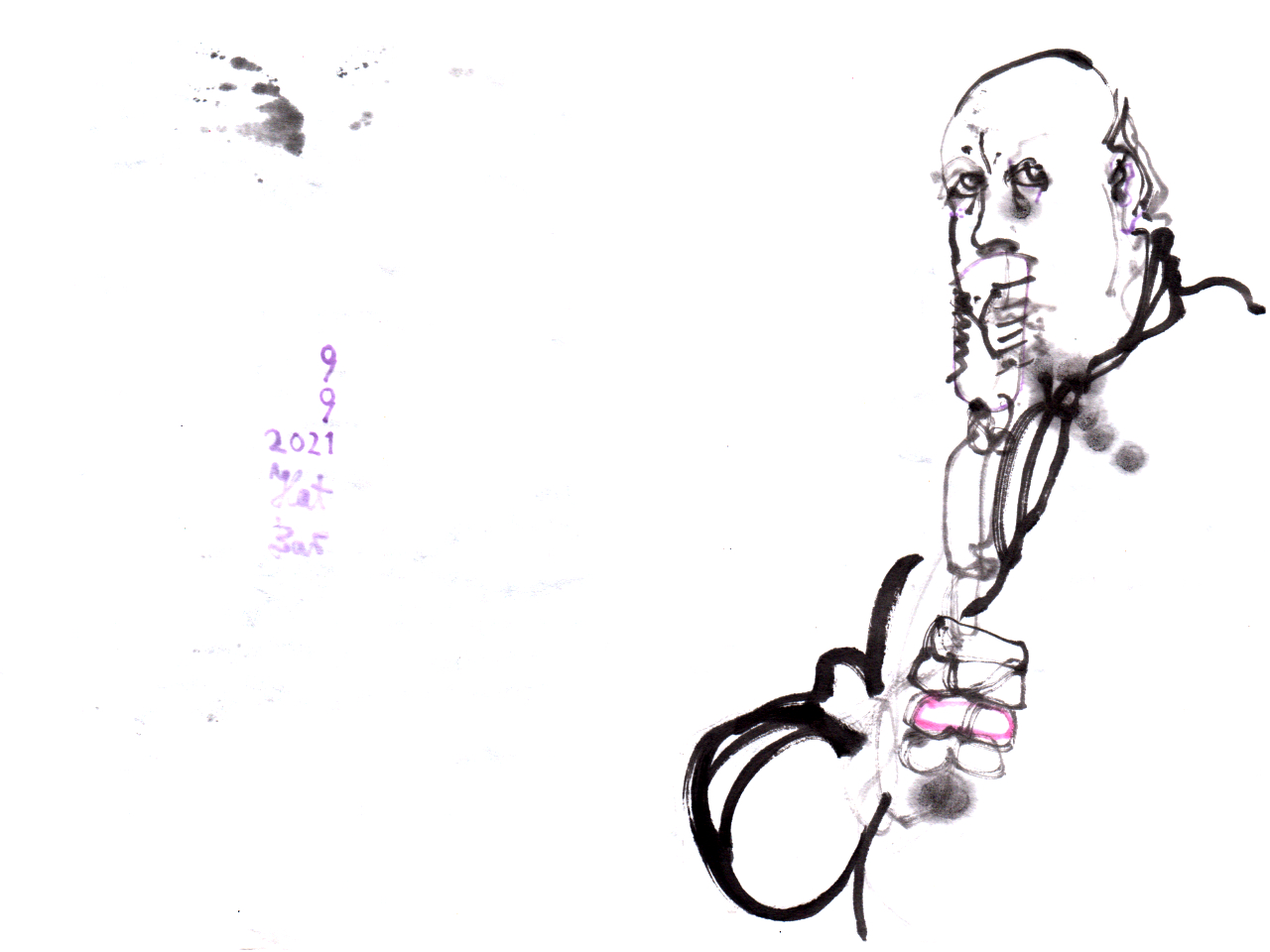
He doesn’t need that, clutches the microphone stand tightly and sings again.
Leave a Reply